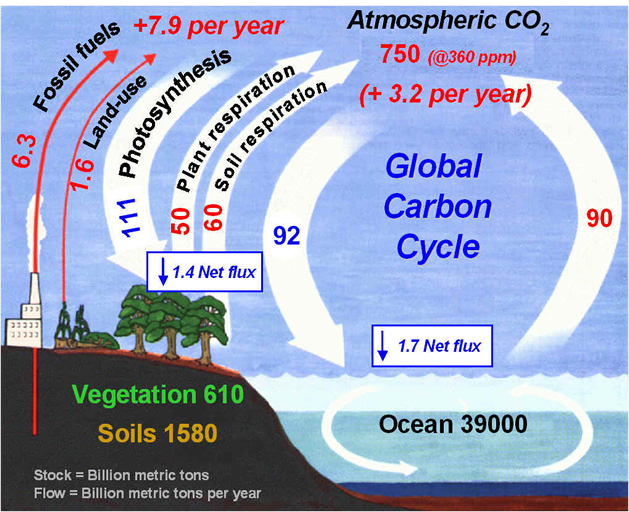Boffins nail oceanic carbon capture process
It’s official: the Southern Ocean sucksBy Richard Chirgwin •
The world’s oceans are known to be carbon sinks, but the process that draws CO2 from the air down into the deep ocean hasn’t been documented.
Until now.
The Argo floats – 80 in total – were deployed in 2002 and collected data for ten years as the basis of this research. CTD (conductivity, density and temperature) profilers were also used to collect data at depths of up to 7 Km, the researchers say.
The Southern Ocean is an important carbon sink (at least for those who believe that anthropogenic carbon emissions are driving climate change – a list which now includes formerly skeptical scientist Richard Muller). It’s calculated to take up as much as 40 percent of the CO2 absorbed by oceans (which in turn soak up a quarter of total annual emissions).
The British Antarctic Survey’s Dr Jean-Baptiste Sallée says the study means scientists are “better placed to understand the effects of changing climate and future carbon absorption by the ocean.”
Collaborator Dr Richard Matear of Australia’s CSIRO noted that while observations had measured the CO2 found in the deep ocean, it’s important to identify the pathways used to get there – particularly since significant climate change could change the behavior of those processes.
Southern Ocean currents are also affected by other atmospheric changes like ozone depletion, which could also change its effectiveness as a carbon sink.
He told The Conversation that the processes the team is researching “sets how much carbon the ocean can take up”.
As well as mapping the processes for incorporation in future modeling, the scientists believe the research could also help assess the effectiveness of methods proposed to increase the ocean’s carbon capture. ®
Until now.
A team of British and Australian scientists have identified huge
plunging currents – as much as 1,000 kilometers wide – that appear to be
key to the process of storing CO2 in the deep ocean. Those
currents, the researchers say, are the result of local eddies (resulting
from a combination of wind, currents, and massive whirlpools) that
create localized pathways down from the surface.
Published in Nature Geoscience, the research
used Argo robotic floats to help explore ocean dynamics up to 2 Km
down, along with analysis of temperature, salinity, and pressure data.The Argo floats – 80 in total – were deployed in 2002 and collected data for ten years as the basis of this research. CTD (conductivity, density and temperature) profilers were also used to collect data at depths of up to 7 Km, the researchers say.
The Southern Ocean is an important carbon sink (at least for those who believe that anthropogenic carbon emissions are driving climate change – a list which now includes formerly skeptical scientist Richard Muller). It’s calculated to take up as much as 40 percent of the CO2 absorbed by oceans (which in turn soak up a quarter of total annual emissions).
The British Antarctic Survey’s Dr Jean-Baptiste Sallée says the study means scientists are “better placed to understand the effects of changing climate and future carbon absorption by the ocean.”
Collaborator Dr Richard Matear of Australia’s CSIRO noted that while observations had measured the CO2 found in the deep ocean, it’s important to identify the pathways used to get there – particularly since significant climate change could change the behavior of those processes.
Southern Ocean currents are also affected by other atmospheric changes like ozone depletion, which could also change its effectiveness as a carbon sink.
He told The Conversation that the processes the team is researching “sets how much carbon the ocean can take up”.
As well as mapping the processes for incorporation in future modeling, the scientists believe the research could also help assess the effectiveness of methods proposed to increase the ocean’s carbon capture. ®
Related articles
- Climate: Ocean currents play key role in capturing carbon (summitcountyvoice.com)
- Scientists discover how carbon is stored in the Southern Ocean (rtcc.org)
- New discovery of how carbon is stored in the Southern Ocean (phys.org)
- Scientists unlock ocean CO2 secrets key to climate: study (reuters.com)
- Southern Ocean Carbon Sink (cleantechies.com)
- Scientists unlock ocean CO2 secrets key to climate (eco-business.com)
- Clue to carbon storage in the Southern Ocean (theconversation.edu.au)
- Scientists find CO2-sucking funnels in Southern Ocean (news.yahoo.com)
- Scientists unlock ocean CO2 secrets key to climate: study (msnbc.msn.com)


No comments:
Post a Comment
Hello and thank you for visiting my blog. Please share your thoughts and leave a comment :)